ArchieVist (talk | contribs) |
m (→Notes and references: Added spanish link) |
||
| Line 266: | Line 266: | ||
[[pl:Darudżystan]] |
[[pl:Darudżystan]] |
||
| + | [[es:Darujhistan]] |
||
[[Category:Cities]] |
[[Category:Cities]] |
||
[[Category:Darujhistan| ]] |
[[Category:Darujhistan| ]] |
||
Revision as of 22:28, 7 May 2020
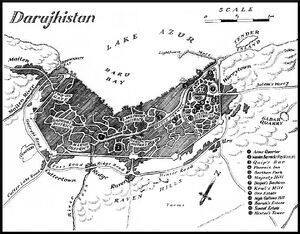
Darujhistan
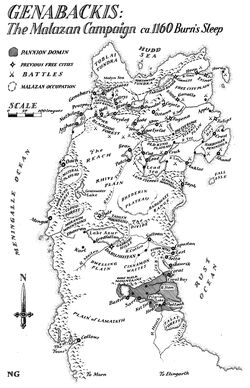
Map Genabackis from GotM
Darujhistan [de-ruh-schistan] was the largest, most influential and last of the Free Cities on Genabackis.[1] It had been called the "City of Cities" and was located on the southern shore of Lake Azur, in the centre of the continent.
Darujhistan was mainly populated by people of Daru and Gadrobi descent.[2] During major festivals, the population of the city expanded to as many as three hundred thousand people.[3]
It was said that the two thousand year old city[4] (Baruk claimed the age to be three thousand years)[5] was built on rumours.[6] According to the scholar Mammot, when rumours of the presence of a Jaghut barrow in the Gadrobi Hills spread, the influx of fortune seekers led to the founding of Darujhistan. The rumours themselves were based on indigenous Gadrobi tribe legends. No barrow was found and the origin of the saying 'born on a rumour' was now unknown to most.[7]
Despite having no standing army, it was said never to have been conquered. Some attributed this to the protective eye of the gods.[8]
Topography
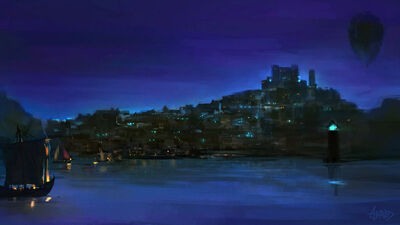
Interpretation of Darujhistan by Artsed
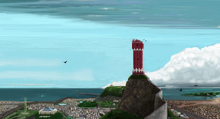
Darujhistan by Roberto C. Kfouri
A wharf sprawled along the shore of Lake Azur.[9] From there, inland from Gadrobi district's harbor, the city rose in four tiers climbing eastward. Ramped cobblestone streets, worn to a polished mosaic, marked Gadrobi district's five Trade Streets. They were the only routes through Marsh district and the next tier, Lakefront district. Beyond Lakefront's crooked aisles twelve wooden gates opened into Daru district. From there, another twelve gates which were manned by the City Watch and barred by iron portcullis, connected the lower and upper cities.[10]
The estates of Darujhistan nobility as well as its publicly known sorcerers were located on the fourth and highest tier. Majesty Hall, where each day the Council gathered sat on a flat-topped hill which was found at the intersection of Old King's Walk and View Street. The hill was encircled by a narrow park, with sandstrewn pathways winding among centuries-old acacias. A castle had once stood upon Majesty Hill and at the park's entrance, near High Gallows Hill, stood a massive rough-hewn gate, it's last-surviving remnant.[11]
The rooftops of Darujhistan consisted of a crowded array of flat tops , arched gables, coned towers, belfries and platforms, preventing sunlight from reaching most of it's streets.[12] Some roof tiles were tarred[13] others made of ceramic.[14]
Some houses were made from brick[15] and the windows of at least some were fitted with thin panes of glass[15][16] others were shuttered.[17]
In tenement buildings, doorways to individual abodes might have curtains rather than solid doors.[17]
The city had over twenty-thousand narrow alleys, barely wide enough for a two-wheeled cart, and an unknown number of major avenues and wider thoroughfares.[18] At least some of the unlit alleys were cobbled and strewn with rubbish.[19]
Districts and named areas
Streets
Estates
Citywall gates
Internal gates
|
Notable Landmarks
|
Law and order
The city was ostensibly ruled by the Noble Council from Majesty Hall but also, behind the scenes, by the members of the T'orrud Cabal. The Assassins' Guild was another factor in the constant power struggle in Darujhistan.
Evaluating how the city operated, Baruk, the unofficial leader of the cabal, told Anomander Rake that the council was the city's machine and although a place of bickering and pettiness, still a place which got things done. He told Rake that the use of the Assassins' Guild provided the noble families with a measure of control over their vendettas, arguments and so forth and that without them the city would have long ago succumbed to civil war.[48]
Charged with upholding the laws passed by the council was the City Watch, whose members would patrol the shadowy streets bearing globed lanterns.[18]
According to Mammot, Darujhistan's 'army' consisted of a handful of noble sons who did nothing but strut back and forth on Whore Street.[49]
The underworld of Darujhistan
Apart from the Assassins' Guild, Darujhistan had a flourishing number of thieves. Amongst the thin hemp clothes lines spanning the streets of the city were others, made out of wrapped wire and securely bolted to the walls, forming what was called the 'Monkey Road' by the thieves.[50]
Members of the thieves guild paid 10% of their income to the guild in order to avoid the attentions of the law,[51] a law that would call for a captured thief to have their hand removed, or execution if they had killed someone during their activities.[citation needed] Notable members included Crokus Younghand.
Culture
Writing was done on parchment.[17]
The colour white and the number twelve were considered to be unlucky. Both of these superstitions went back to the Age of Tyrants. No buildings within the city were painted white apart from places related to death, such as a mausoleum.[52]
It was customary to wear black upon the death of a relative.[53]
Climate
Around the time of the year when Darujhistan celebrated the Gedderone Fête, the city often experienced rains coming from the north.[54]
Calendar
Darujhistan celebrated the start of a new year on the Gedderone Fête on the first day of Spring. Each year for the past millennium was given a name based on an arcane mechanical device known as the Wheel of Ages. It was created by Icarium and displayed in Majesty Hall. The Darujhistan year ending in 1163BS was the Year of the Tusk. This gave way to the Year of the Moon's Tears.[55]
The gas supply
The extensive excavations at the time of the hunt for the fabled Jaghut barrow led to the discovery of underground caverns of gas.[56] From around 260 BS onwards, the gas was channelled to provide light for the city.[18] It was the only known city to use natural gas in this way.[2] The distinct blue flame produced by burning natural gas cast a sapphire glow into the sky at night.[57] Darujhistan was sometimes referred to as the "City of Blue Fire".[58][59]
Almost all but the major streets of the city had no direct sunlight. Some of those streets and alleys were lit by gas torches which were hollowed shafts that gripped a pumice stone with fingers of black iron. The gas for those torches was drawn from the underground caverns and controlled by massive valves, then fed through ancient pitted copper pipes. Only major avenues and thoroughfares were lit by gas, over twenty-thousand narrow alleys remained unsupplied.[18] Gas was also used by the wealthy, like House D'Arle for example, to illuminate parts of their property.[60]
Occasionally fires would break out and flames might reach hundreds of feet into the sky.[18]
The workers servicing the gas supply were called the Greyfaces.[18]
At some point, when the tunnels leading to Darujhistan's gas supply were extended, eight hidden chambers were found carved from the earth by antler picks and decorated with scenes of a glorious past painted in spit, hematite, charcoal, blood, and snot. Each chamber contained a small pedestal upon which copper body ornaments were found. The artists had named themselves (presumably by marking their works) and the finest seers in Darujhistan had identified them as the mortals whose spirits were later worshipped by the Rhivi.[61]
Organisations
- Assassins' Guild
- Guild of Blacksmiths
- Guild of Guards, Sentinels, Wardens, and Gate-men
- Noble Council
- Philosophical Society
- T'orrud Cabal
- Trygalle Trade Guild
Notable Inhabitants
- Baruk: High alchemist and member of the T'orrud Cabal
- Coll: Onetime city councillor and aristocrat, also a drunk and a regular at the Phoenix Inn.
- Crokus: A young thief and nephew to Mammot.
- Kruppe: A fence, a regular at the Phoenix Inn and a man of surprising depths.
- Mammot: A mage, historian of Darujhistan, uncle to Crokus, member of the T'orrud Cabal.
- Murillio: A courtier and regular at the Phoenix Inn.
- Rallick Nom: An assassin and a regular at the Phoenix Inn.
- Vorcan: High Mage, Master of Assassins and member of the T'orrud Cabal.
In Gardens of the Moon
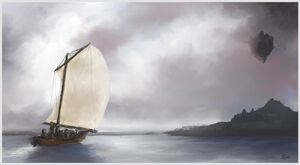
'Into Darujhistan' by Corporal Nobbs
After the Siege of Pale, the Malazan Empire shifted its focus of attention to Darujhistan. The city provided the location for the majority of events from chapter five onwards.
A large faction of the council, led by Turban Orr, hoped that by declaring neutrality they would be spared the fate of Pale. Orr tried to gain the support of the alchemist Baruk by promising that the mages of the city would be safe under the declaration. Baruk however declined to be drawn in and Orr told him that even without his help, a majority support reached that night would ensure the vote to go in favour of his proposals.[62][63]
Orr did not know that Baruk, unofficial leader of the mages of the T'orrud Cabal, was already negotiating the support of the Lord of Moon's Spawn, Anomander Rake against the expected invasion. Neither of the men realized that an advance contingent of the Malazan Empire had already infiltrated the city. A squad of Bridgeburners under Sergeant Whiskeyjack, was busily mining the major intersections of Darujhistan with Moranth munitions.
At the same time, attempts by the Malazans to contact the local Assassins' Guild were thwarted by Rake's Tiste Andii night-hunters who wiped out a large part of the guild in ambushes.
Events came to a head at a fete organized by Lady Simtal where the appearance of the Jaghut Tyrant Raest caused havoc. The fight against him resulted in the appearance of a new Azath House. During the fete, the Malazans made contact with the mistress of the guild, Vorcan, who took on the contract to kill the members of the T'orrud Cabal. She killed three of them but was wounded and took refuge in the newly arisen Azath House.
The Malazans decided against detonating the intersections once they realized that, due to the presence of the gas supply in those locations, doing so would set the entire city ablaze.
Amongst those who played a large part throughout the events, were regular patrons of the Phoenix Inn in Darujhistan.
In Deadhouse Gates
Fiddler received a box of Moranth Munitions, sent to him by Quick Ben. When he asked what the mage had said about the source, the reply was that it came from the Blue City's streets. It is highly likely that this was a cryptic reference to the Munitions used previously to mine the intersections.[64]
In Memories of Ice
The city sent Councillors Estraysian D'Arle and Coll to represent Darujhistan in negotiations with the merged forces of Caladan Brood and Onearm's Host. They successfully concluded an arrangement to supply the combined armies as they marched against the Pannion Domin through the use of the Trygalle Trade Guild.[65]
For two weeks, the Gadrobi district was plagued by a series of murders. Horribly mangled bodies were found every night. A mage was hired to investigate, but whatever he found terrified him. The Noble Council even went so far as to hire the Assassins' Guild to look into the matter, but no culprit was ever found. Instead, the killings stopped on their own. The presence of notorious necromancers Bauchelain and Korbal Broach in the city at that time may have been merely coincidental.[66]
In The Bonehunters
Cutter encountered the undead Soldier of High House Death in Seven Cities and the ancient Seguleh spoke of Darujhistan in ways that confused the young thief. The Soldier asked Cutter if the Tyrant's children still ruled the city and whether the Tyrant's Seguleh army still held sway. When told there was no Tyrant, the Soldier spoke of the T'orrud Cabal as a group of undying, secretive, paranoid mages preparing for the inevitable return of the Tyrant. Among them he named Barukanal, Derudanith, Travalegrah, and Mammoltenan. He called Cutter's claim that Mammot was his uncle absurd.[67]
In Toll the Hounds
(Information needed)
In Orb Sceptre Throne
(Information needed)
Trivia
- The city of Darujhistan was invented and mapped by author Ian C. Esslemont for the Malazan role-playing games he played with Steven Erikson.[68]
Notes and references
- ↑ Gardens of the Moon, Chapter 4, UK MMPB p.156
- ↑ 2.0 2.1 Gardens of the Moon, Glossary, UK MMPB p.710
- ↑ Gardens of the Moon, Chapter 22, US HC p.453
- ↑ Gardens of the Moon, Chapter 5, US HC p.134
- ↑ Gardens of the Moon, Chapter 13 US HC p.307
- ↑ Gardens of the Moon, Chapter 6, UK MMPB p.217
- ↑ Gardens of the Moon, Chapter 11, UK MMPB p.370
- ↑ House of Chains, Chapter 3, US SFBC p. 145
- ↑ Gardens of the Moon, Chapter 5, UK MMPB p.177
- ↑ Gardens of the Moon, Chapter 6, UK MMPB p.194/195
- ↑ Gardens of the Moon, Chapter 6, UK MMPB p.195
- ↑ Gardens of the Moon, Chapter 5, UK MMPB p.177/178
- ↑ Gardens of the Moon, Chapter 5, UK MMPB p.182
- ↑ Gardens of the Moon, Chapter 5, UK MMPB p.186
- ↑ 15.0 15.1 Gardens of the Moon, Chapter 5, UK MMPB p.188
- ↑ Gardens of the Moon, Chapter 6, UK MMPB p.198
- ↑ 17.0 17.1 17.2 Gardens of the Moon, Chapter 5, UK MMPB p.189
- ↑ 18.0 18.1 18.2 18.3 18.4 18.5 Gardens of the Moon, Chapter 5, UK MMPB p.178
- ↑ Gardens of the Moon, Chapter 5, UK MMPB p.183
- ↑ Orb Sceptre Throne, Prologue
- ↑ Gardens of the Moon, Chapter 7, UK MMPB p.223
- ↑ Blood and Bone, Chapter 1, UK MMPB p.43
- ↑ Gardens of the Moon, Chapter 7, US HC p.173
- ↑ Gardens of the Moon, Chapter 7, US HC p.175
- ↑ Memories of Ice, Chapter 2
- ↑ Gardens of the Moon, Chapter 7, UK MMPB p.220
- ↑ Gardens of the Moon, Chapter 7, US HC p.175
- ↑ Orb Sceptre Throne, Chapter 12, UK MMPB p.500
- ↑ Toll the Hounds, Chapter 19, UK HB p.719
- ↑ Gardens of the Moon, Chapter 7, UK MMPB p.220
- ↑ Toll the Hounds, Chapter 19, UK HB p.719
- ↑ Toll the Hounds, Chapter 19, UK HB p.700/719
- ↑ Toll the Hounds, Chapter 19, UK HB p.719
- ↑ Gardens of the Moon, Chapter 13, US HC p.318
- ↑ Gardens of the Moon, Chapter 7, US HC p.175
- ↑ Gardens of the Moon, Chapter 6, US HC p.156
- ↑ Gardens of the Moon, Chapter 7, US HC p.173
- ↑ Deadhouse Gates, Chapter 20, US HC p.517
- ↑ Toll the Hounds, Chapter 21, US TPB p.714
- ↑ Toll the Hounds, Chapter 9, US TPB p.281
- ↑ Gardens of the Moon, Chapter 7, US HC p.175
- ↑ Toll the Hounds, Chapter 7, US TPB p.206
- ↑ Toll the Hounds, Chapter 7, US TPB p.206
- ↑ Gardens of the Moon, Chapter 7, US HC p.167
- ↑ Toll the Hounds, Chapter 5, US TPB p.140
- ↑ Deadhouse Gates, Chapter 19, US HC p.507
- ↑ Toll the Hounds, Chapter 21, US TPB p.717
- ↑ Gardens of the Moon, Chapter 13, UK MMPB p.438/439
- ↑ Gardens of the Moon, Chapter 5, UK MMPB p.185
- ↑ Gardens of the Moon, Chapter 5, UK MMPB p.187/188
- ↑ Gardens of the Moon, Chapter 19
- ↑ Orb Sceptre Throne
- ↑ Gardens of the Moon, Chapter 7, UK MMPB p.226
- ↑ Gardens of the Moon, Chapter 7, UK MMPB p.225
- ↑ Gardens of the Moon, Chapter 20, US HC p.402
- ↑ Gardens of the Moon, Chapter 13 UK MMPB p.425
- ↑ Gardens of the Moon, Chapter 6, UK MMPB p.194
- ↑ Toll the Hounds, Chapter 1, UK HC p.13
- ↑ Toll the Hounds, Chapter 3, UK HC p.81
- ↑ Gardens of the Moon, Chapter 5, UK MMPB p.179
- ↑ Memories of Ice, Chapter 8, UK MMPB p.367-368
- ↑ Gardens of the Moon, Chapter 5, UK MMPB p.184
- ↑ Gardens of the Moon, Chapter 6, UK MMPB p.203/205
- ↑ Deadhouse Gates, Chapter 20, UK MMPB p.810
- ↑ Memories of Ice, Chapter 5
- ↑ Memories of Ice, Chapter 4, US SFBC p.122
- ↑ The Bonehunters, Chapter 4, US SFBC p.161
- ↑ An Evening with Steven Erikson by Nerdaí Irish Nerds - See 18:13
